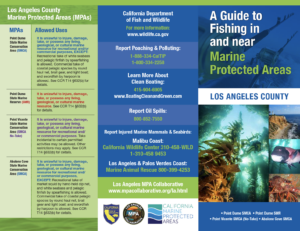Since their implementation in Southern California in 2012, marine protected areas (MPAs) are considered to be an essential part of ecosystem-based management regimes and may play a major role in managing responses to climate change effects on habitat and species resilience. In addition to playing a significant role in their implementation based on the best available science, USC Sea Grant also co-leads the Los Angeles regional MPA Collaborative, one of the statewide networks charged with fostering the state’s implementation of education and enforcement programs and developing new outreach strategies for the MPA network. USC Sea Grant continues to work diligently with local, regional, state, and federal partners to ensure that the aims of Southern California’s MPAs are well understood and supported by the public through partnering closely with diverse parties from both coastal and inland communities, including Indigenous peoples. Further, USC Sea Grant works closely with the National Marine Sanctuary Program and other federal entities who have jurisdiction over marine protected areas.
Recent Research
Community Engagement
-
MPA Collaboratives were formed at the statewide and regional level to provide a localized, comprehensive approach to resource management by bringing together local experts in the areas of outreach, education, enforcement, compliance, and scientific research and monitoring. USC Sea Grant has been co-chair of the Los Angeles MPA Collaborative since its inception. We help guide projects that aid in the enforcement and public education of marine protected areas in Southern California. Several products, including maps, guides, informational brochures, beach signage identifying MPAs, and fishing information, have been published and distributed in English and Spanish.
-
The Channel Islands National Marine Sanctuary (CINMS) is a marine protected area that expands across 1,470 square miles off the Southern California coast. The Sanctuary hosts valuable commercial and recreational activities and is a special place for species close to extinction, sensitive habitats, shipwrecks, heritage artifacts, and the indigenous Chumash people. CINMS established a Sanctuary Advisory Council (SAC) in 1998 to ensure the continued participation of stakeholders in advising Sanctuary management, promoting the long-term conservation of the sanctuary waters, wildlife, habitats, and cultural resources while allowing compatible human uses. The SAC hosts public forums to deliberate resource management issues. USC Sea Grant professional Phyllis Grifman has a long-standing relationship with the CINMS and has served on the SAC for over 15 years, including three years as Chair. Grifman continues to serve as both the Research Seat of the CINMS SAC and the Chair of the Research Activities Panel, assisting in expanding membership to diverse communities and creating a new steering committee.
-
MPA Watch is a citizen-science program, created and run by Heal the Bay and sponsored by USC Sea Grant. MPA Watch trains volunteers to observe and collect unbiased data on coastal and marine resource use. This data provides valuable information to help managers understand how people are using the new South Coast MPAs, established under the Marine Life Protection Act.
Related Links
-
Los Angeles County: A Guide to Fishing In and Near Marine Protected Areas (published 2017)

